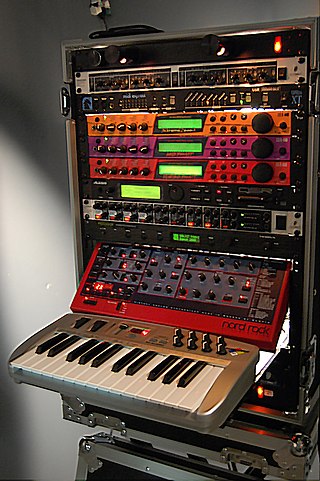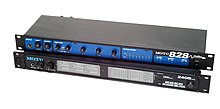
MIDI is a technical standard that describes a communication protocol, digital interface, and electrical connectors that connect a wide variety of electronic musical instruments, computers, and related audio devices for playing, editing, and recording music.

A sound card is an internal expansion card that provides input and output of audio signals to and from a computer under the control of computer programs. The term sound card is also applied to external audio interfaces used for professional audio applications.

Sound Blaster is a family of sound cards and audio peripherals designed by Creative Technology/Creative Labs of Singapore. The first Sound Blaster card was introduced in 1989.

A mixing console or mixing desk is an electronic device for mixing audio signals, used in sound recording and reproduction and sound reinforcement systems. Inputs to the console include microphones, signals from electric or electronic instruments, or recorded sounds. Mixers may control analog or digital signals. The modified signals are summed to produce the combined output signals, which can then be broadcast, amplified through a sound reinforcement system or recorded.

The game port is a device port that was found on IBM PC compatible and other computer systems throughout the 1980s and 1990s. It was the traditional connector for joystick input, and occasionally MIDI devices, until made obsolete by USB in the late 1990s.

Virtual Studio Technology (VST) is an audio plug-in software interface that integrates software synthesizers and effects units into digital audio workstations. VST and similar technologies use digital signal processing to simulate traditional recording studio hardware in software. Thousands of plugins exist, both commercial and freeware, and many audio applications support VST under license from its creator, Steinberg.

Pro Tools is a digital audio workstation (DAW) developed and released by Avid Technology for Microsoft Windows and macOS. It is used for music creation and production, sound for picture and, more generally, sound recording, editing, and mastering processes.

A digital audio workstation is an electronic device or application software used for recording, editing and producing audio files. DAWs come in a wide variety of configurations from a single software program on a laptop, to an integrated stand-alone unit, all the way to a highly complex configuration of numerous components controlled by a central computer. Regardless of configuration, modern DAWs have a central interface that allows the user to alter and mix multiple recordings and tracks into a final produced piece.

A TV tuner card is a kind of television tuner that allows television signals to be received by a computer. Most TV tuners also function as video capture cards, allowing them to record television programs onto a hard disk much like the digital video recorder (DVR) does.

Media Composer is a non-linear editing (NLE) software application developed by Avid Technology. First introduced in the late 1980s and widely adopted in the 1990s, it has become a prominent tool in the professional editing landscape, particularly in the film, television, and broadcast industries. Media Composer is used in a variety of production environments, including feature films, television shows, documentaries, and streaming service content.

Vinyl emulation allows a user to physically manipulate the playback of digital audio files on a computer using the turntables as an interface, thus preserving the hands-on control and feel of DJing with vinyl. This has the added advantage of using turntables to play back audio recordings not available in phonograph form. This method allows DJs to scratch, beatmatch, and perform other turntablism that would be impossible with a conventional keyboard-and-mouse computer interface or less tactile control devices.

Sound Blaster Live! is a PCI add-on sound card from Creative Technology Limited for PCs. Moving from ISA to PCI allowed the card to dispense with onboard memory, storing digital samples in the computer's main memory and then accessing them in real time over the bus. This allowed for a much wider selection of, and longer playing, samples. It also included higher quality sound output at all levels, quadrophonic output, and a new MIDI synthesizer with 64 sampled voices. The Live! was introduced on August 11, 1998 and variations on the design remained Creative's primary sound card line into the early 2000's.

Sound Blaster Audigy is a product line of sound cards from Creative Technology. The flagship model of the Audigy family used the EMU10K2 audio DSP, an improved version of the SB-Live's EMU10K1, while the value/SE editions were built with a less-expensive audio controller.

An adapter in regard to computing can be either a hardware component (device) or software that allows two or more incompatible devices to be linked together for the purpose of transmitting and receiving data. Given an input, an adapter alters it in order to provide a compatible connection between the components of a system. Both software and hardware adapters are used in many different devices such as mobile phones, personal computers, servers and telecommunications networks for a wide range of purposes. Some adapters are built into devices, while the others can be installed on a computer's motherboard or connected as external devices.

The Media Vision Pro AudioSpectrum family of personal computer sound cards included the original 8-bit Pro AudioSpectrum (1991), the 8-bit Pro AudioSpectrum Plus, 16-bit Pro AudioSpectrum 16, Pro AudioSpectrum 16 Basic and 16-bit Pro Audio Studio. All PAS cards with the exception of Pro AudioSpectrum 16 Basic could connect to CD-ROM drives — variants having SCSI or various proprietary interfaces — and many were sold in multimedia kits with compatible CD-ROM drives.
VENUE is a brand of live sound digital mixing consoles introduced by Digidesign in February 2005. The family now includes 5 different consoles and a number of ways they can be configured. They can all be connected to Pro Tools, the audio editing software also created by Avid/Digidesign, to provide recording and 'Virtual Soundcheck' facilities. One of the system's key marketing points is its use of the same AAX DSP/TDM plugins as Pro Tools, an industry standard digital audio workstation (DAW). This is designed to enable the sounds recorded by the artist in the studio to be easily recreated on stage, and to allow for greater flexibility in signal processing without heavy and mechanical-shock-sensitive racks of external processors. There is also a PC-based offline editor for creation and editing of show files, although there is no audio processing in the editor.

The H2 Handy Recorder is a handheld digital audio recorder from Zoom first announced at the NAMM Show in February 2007. It records very high quality digital stereo or 4-channel audio on a hand-held unit, and has been called "the studio on a stick."
Audio connectors and video connectors are electrical or optical connectors for carrying audio or video signals. Audio interfaces or video interfaces define physical parameters and interpretation of signals. Some connectors and interfaces carry either audio only or video only, whereas others carry both, audio/video.
A sound card mixer is the analog part of a sound card that routes and mixes sound signals. This circuit receives inputs from both external connectors and the sound card's digital-to-analog converters. It selects or mutes, amplifies these signals, adds them together, and finally routes the result to both external output connectors and the sound card's analog-to-digital converters. Different mixing schemes are in use, but the ones implemented in most IBM-PC compatible computers today are variants of a scheme defined in Intel's AC'97 Audio Component Specification.

A matrix mixer is an audio electronics device that routes multiple input audio signals to multiple outputs. It usually employs level controls such as potentiometers to determine how much of each input is going to each output, and it can incorporate simple on/off assignment buttons. The number of individual controls is at least the number of inputs multiplied by the number of outputs.


















